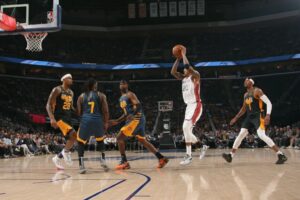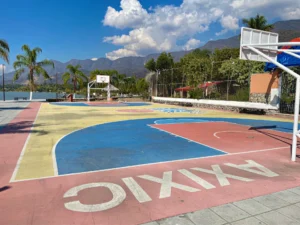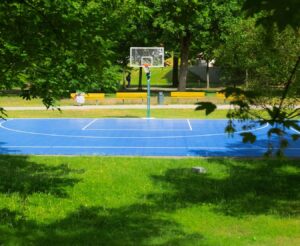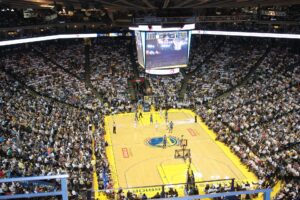Basketball is a dynamic game that requires skill, strategy, and the right playing surface. The type of surface you choose can make a huge difference. It affects the way the game is played, as well as the safety of the players. Indoor and outdoor basketball courts have distinct differences in their surface characteristics. So it impacts the game in various ways.
Choosing between indoor and outdoor basketball courts depends on your specific needs. Indoor courts offer controlled conditions, consistent surfaces, and better lighting, making them suitable for competitive play and professional games. Outdoor courts provide a more casual and accessible setting, although they are subject to weather conditions and may have less predictable surfaces. Consider your preferences, level of play, and available facilities to determine the best fit for you.
This article will explore the differences between indoor and outdoor basketball court surfaces. Also, we will discuss the advantages and disadvantages of each. We’ll discuss important factors for picking the best surface for you.
Knowing these differences is helpful, whether you play basketball professionally or for fun. It can help you make an informed decision on the best surface to play on. So, let’s discuss each of them one by one.
I. Indoor Basketball Court Surfaces
Several characteristics of indoor basketball can make them unique compared to outdoor courts. These characteristics include the materials used, surface texture, and color.
A. Materials Used
Indoor basketball courts are usually made with hardwood, synthetic materials, or rubber. Hardwood is the traditional surface used for indoor basketball courts. Also, it is made from maple, oak, or a combination of both.
But synthetic surfaces use materials like polyurethane, vinyl, or acrylic. Rubber surfaces are also becoming more popular. This is due to their durability and easy maintenance.
B. Surface texture
Indoor courts can be smooth, a bit textured, or have deep grooves. The texture of the surface affects the grip and traction of the players’ shoes. This is important for their performance and safety.
C. Color
Indoor basketball court surfaces can come in a variety of colors. It ranges from natural wood to painted surfaces to multi-colored designs. Surface color can influence how players see the ball and their environment.
Next, let’s look at the advantages of indoor basketball court surfaces.
Advantages of Playing on Indoor Basketball Court Surfaces
There are several advantages to playing basketball on an indoor court surface. These advantages include:
Better traction:
Indoor basketball court surfaces provide better traction for players. It is due to the surface’s grip and the lack of outdoor elements such as dirt or moisture.
More consistent bounce:
Indoor basketball court surfaces have a more consistent. Additionally, they have predictable bounce compared to outdoor surfaces. However, this can vary due to weather conditions and surface irregularities.
Lower risk of injuries:
Indoor basketball court surfaces are typically designed with player safety in mind. Features such as shock absorption and non-slip surfaces reduce the risk of injuries.
Now, let’s look at some examples.
Examples of popular indoor basketball court surfaces
Here are a few popular examples of indoor basketball court surfaces.
Hardwood:
Hardwood is the most common surface material used for indoor basketball courts. It is due to its durability, shock absorption, and natural traction. Hardwood surfaces are typically made from maple, oak, or a combination of both.
Rubber:
Rubber surfaces are becoming more popular for indoor basketball courts. This is because of their durability, easy maintenance, and shock absorption. They are also less expensive than hardwood surfaces.
Synthetic:
Synthetic surfaces are made from a variety of materials, such as polyurethane, vinyl, or acrylic. They offer a consistent and durable surface with good traction. However, they can be more expensive than rubber or hardwood surfaces.
Now, let’s discuss the outdoor basketball court surfaces in detail.
II. Outdoor Basketball Court Surfaces
Outdoor basketball court surfaces have their own unique characteristics. These differences include the materials used, surface texture, and color. Let’s discuss each of these differences in detail.
A. Characteristics Of Outdoor Basketball Court Surfaces
The following are the characteristics of outdoor basketball court surfaces.
Materials used:
Outdoor basketball courts are usually made of asphalt, concrete, or rubber.
Asphalt and concrete are the traditional materials used for outdoor courts. They are perfect due to their durability and weather resistance.
Rubber surfaces are becoming more popular due to their shock-absorbing properties. Also, they are more forgiving on joints than concrete or asphalt.
Surface texture:
Outdoor basketball court surfaces can be rough or smooth. It depends on the materials used and the treatment of the surface. Some surfaces may be painted to add texture or color.
Color:
Outdoor basketball court surfaces can come in a variety of colors. It ranges from natural gray to colored or multi-colored surfaces.
B. Advantages And Disadvantages Of Playing On Outdoor Basketball Court Surfaces
Below are some advantages and disadvantages of outdoor basketball court surfaces.
More durable:
Outdoor basketball court surfaces are typically more durable than indoor surfaces. This is because of the materials used. Additionally, they are specially designed to withstand the elements.
More weather-resistant:
Outdoor basketball court surfaces can withstand extreme weather conditions. Thus, making them ideal for year-round use.
Higher risk of injuries:
Outdoor basketball court surfaces can be more dangerous than indoor surfaces. It is due to factors such as uneven surfaces, poor drainage, and the potential for debris on the court.
C. Examples of popular outdoor basketball court surfaces
Examples of popular outdoor basketball court surfaces are as follows.
Asphalt:
Asphalt is the most common material used for outdoor basketball courts. This is due to its durability, low cost, and easy maintenance. However, it can be hard on the joints and tends to crack over time.
Concrete:
Concrete is another popular material used for outdoor basketball courts. It is popular due to its durability and weather resistance. You can paint it to add texture or color. Yet it can also be hard on the joints.
Rubber:
Rubber surfaces are becoming more popular for outdoor basketball courts.
The reason is their shock-absorbing properties and their more forgiving on joints than concrete or asphalt. They also offer good traction and are easy to maintain.
III. Differences in Gameplay
Indoor and outdoor basketball court surfaces differ greatly, affecting how the game is played.
Below are some of the ways that these differences can affect the game:
A. Ball control
Indoor basketball court surfaces tend to be smoother than outdoor surfaces. This can make it easier to dribble and control the ball.
Outdoor basketball court surfaces can be rough and uneven. Hence, making it more difficult to control the ball.
B. Foot traction
Indoor basketball court surfaces tend to offer better traction. This can help players move more quickly and change direction more easily.
Outdoor basketball court surfaces can be more slippery, especially when wet. Thus, making it more difficult to maintain traction. Also, it increases the risk of slipping and falling.
C. Bounce
Indoor basketball court surfaces tend to offer a more consistent bounce. All this can help players predict where the ball will go.
Outdoor basketball court surfaces can produce unpredictable bounces. As a result, it makes it more difficult to anticipate where the ball will go.
D. Pace of Play
Indoor basketball court surfaces tend to be smaller than outdoor surfaces. It can lead to a faster pace of play.
Outdoor basketball court surfaces tend to be larger. That’s why it can lead to a slower pace of play and more emphasis on half-court offense.
E. Physical Strain on the Body
Indoor basketball court surfaces tend to be more forgiving on the body. This is because they offer better shock absorption. Additionally, they are typically made from materials that are easier on the joints.
Outdoor basketball court surfaces can be harder on the body. The reason behind this is their harder manufacturing materials. Also, they may be more susceptible to wear and tear.
All this information will help you to choose the right basketball court surface. Next, let’s consider the factors before deciding something final.
IV. Factors To Consider When Choosing A Basketball Court Surface
When choosing a basketball court surface, there are several factors to consider, including:
A. Location and Climate
Indoor basketball court surfaces are ideal for areas with extreme weather conditions. For example, areas with heavy snowfall or high temperatures.
Outdoor basketball court surfaces are best for areas with milder climates. For instance, areas with mild winters and cooler summers.
B. Budget And Maintenance Requirements
Indoor basketball court surfaces tend to be more expensive than outdoor surfaces. The reason behind this is the materials used and installation costs.
Outdoor basketball court surfaces can be less expensive. However, they might need more care, like fixing cracks and refreshing lines.
C. Level of Play (e.g., recreational vs. professional)
Professional basketball players require surfaces that provide consistent bounce and traction. For this, indoor surfaces are more appropriate.
Recreational players may prefer outdoor surfaces for their lower cost and greater availability.
D. Personal Preferences
Some players may have personal preferences for a particular type of surface. It depends on their past experiences or playing style. Other players may prefer a certain color or design for aesthetic reasons.
Let’s discuss a trustworthy partner for constructing your desired basketball court flooring.
Copo Sports – An Ideal Basketball Courts Flooring Solution
Copo Sports is a durable and versatile basketball court flooring solution. It offers superior shock absorption and traction.
Moreover, Copo Sports is easy to clean and maintain, making it a practical and affordable choice for any sports facility. Overall, it’s the best option for creating a safe and enjoyable basketball environment.

Conclusion
Choosing the right surface is crucial. It ensures players’ safety and optimal performance on basketball courts. There are significant differences between indoor and outdoor basketball court surfaces. Both are made of different materials and have different sets of pros and cons.
When choosing a basketball court surface, think about the cost, how long it will last, how safe it is, and how easy it is to maintain. Personal preference and specific needs also play a significant role in decision-making. Understanding the differences can help players make informed choices. It can enhance performance and ensure safety.
FAQs
What are the different types of basketball court surfaces?
The different types of basketball court surfaces include hardwood courts, asphalt courts, rubber courts, synthetic indoor courts, tartan courts, and grass courts.
What materials are used for outdoor basketball courts?
The materials commonly used for outdoor basketball courts are asphalt or concrete for the base surface and rubber or acrylic paint for the court markings and color.
Which surface is best for basketball?
Hardwood courts are generally considered the best surface for basketball due to their smooth and consistent playing surface, excellent traction, and ability to provide optimal ball bounce and player movement.
Read More









